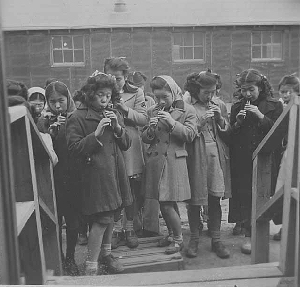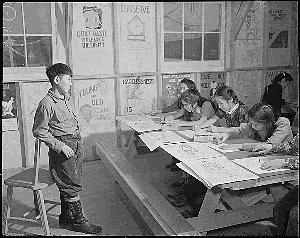Children of Minidoka
|
|
This website page is dedicated to furthering the knowledge of the children in Minidoka relocation camp. Minidoka also known as Hunt was one of the many camps during World War II created for the interment of Japanese and Japanese Americans. Children were included as part of the population that was relocated to the camps. Although surrounded by barbed wire and watch towers, the children still experienced many of the same activites as children did outside of camp. This website presents selected documents illustrating children's lives in Minidoka. I: BackgroundThe United States entered World War II after the bombing of Pearl Harbor by the Japanese on December 7, 1941. In contrast to what many Americans believe or were taught, the suspicion of Japanese people as potentially dangerous persons began well before the attack on Pearl Harbor, and even before the rest of the world entered World War II in 1939. As early as 1922 the US government had been monitoring the activities of Japanese Americans on Bainbridge Island, Washington. In 1936, lists were being formed to include names of people of Japanese ancestry in case an event should rise. Immediately following the attack, these compiled lists were used to round up Japanese American community members, who were thought to be responsible or could be responsible for subversive activities against the country. Both the public and the federal administrators harbored a sentiment of suspicion towards all persons of Japanese descent before and during the war, although there was no act of espionage or sabotage found. This event would bring to the forefront the racism and prejudice that many Americans held towards persons of Japanese ancestry. On February 19, 1942, six weeks after the attack on Pearl Harbor, President Franklin D. Roosevelt signed Executive Order 9066, which allowed the Secretary of War and other military commanders the power to exclude all persons, citizens and non citizens alike, from designated areas to prevent any and all types of espionage or sabotage. Initially in the mainland, people of Japanese ancestry were encouraged to move out of the exclusion areas, which included the western half of Washington, Oregon and California and the southern half of Arizona. Later the entire state of California was designated as a military exclusion zone. However, the Western Defense Command made it a requirement that all Japanese Americans in these designated areas be placed into permanent relocation centers. Beginning in May of 1942, the U.S. government announced its relocation policy and required that Japanese Americans, Japanese nationals, and their families register with the government. Its primary aim was to remove all persons of Japanese ancestry in the designated Exclusion Area. Persons with as small as one sixteenth Japanese blood were required to register. Many families were given brief notice before they were uprooted from their homes and forced to liquidate their material belongings before being shipped off to unknown destinations. They were placed in temporary assembly facilities, such as stadiums and fairgrounds throughout the West Coast, while more permanent locations were built in the interior. Those persons from the Pacific Northwest were stationed at the Puyallup Fairgrounds, along with persons from Alaska. The conditions of these centers were poor and families were forced to live in hastily built shacks or empty horse stalls. Communal bathrooms and dining areas were also standard for both the assembly and relocation centers. Eventually those from the Northwest were relocated to Hunt, Idaho at a camp called Minidoka. II: Children's life in MinidokaChildren as well as infants were part of the group seen as dangerous. Because of their race they were removed along with their families for the "protection" of the United States. These children were taken away from their friends and schools and were placed into camps without a formal system of education or facilities. The US government created schools, with little supplies and fewer teachers. These schools created an assemblance of real life for the children, and gave them a place to learn, grow, and play. Clubs and sports teams were formed. There were many camps created in the interior of the United States that interned children. An example of one such camp is Minidoka, located in Hunt, Idaho. The children in Minidoka primarily came from Washington, Oregon and Alaska. They ranged in age from newborn to seventeen. The Japanese Americans tried to create a life as normal as possible under the conditions. Though the Japanese Americans did not have much freedom to roam around outside of camps, children were to able to form extracurricular activities such as newspapers, choir, drama clubs, sports teams and dance halls. Movies were even shown. Thus life in Minidoka, stripped of some freedoms, created a normal childhood life. |


